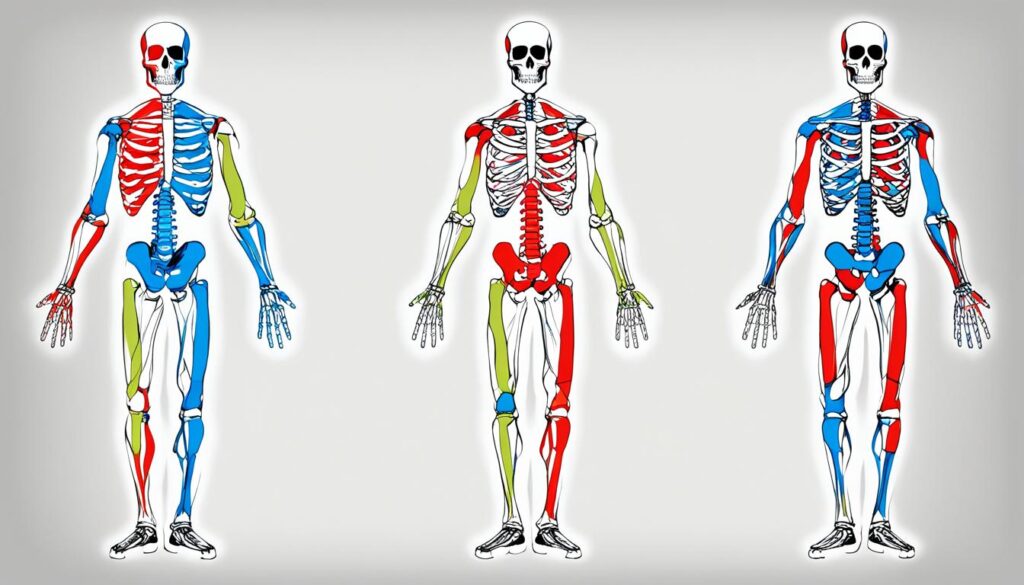Are you tired of trying every muscle-building fad and still not seeing the results you desire? Building natural, sustainable muscle mass can be a journey, but it’s one worth taking. What if you could uncover the expert-backed strategies to pack on lean muscle, boost strength, and enhance your overall physique?
In this comprehensive guide, we’ll reveal the insider tips and proven methods that fitness experts swear by for building muscle mass naturally. From optimizing your training and nutrition to mastering recovery and progression, get ready to unlock your true muscular potential1.
Key Takeaways
- Muscle mass and cross-sectional area can decrease with age, leading to conditions like sarcopenia and osteopenia1.
- Regular strength training can improve blood pressure, glycemic control, lipid profiles, and mental health1.
- Protein intake of 1 gram per pound of body weight is crucial for muscle hypertrophy1.
- Adequate sleep of 7-8 hours per night is essential for muscle repair and growth1.
- Consistency and dedication are vital for successful natural muscle building2.
The Basics of Building Muscle
Skeletal muscles are a series of parallel cylindrical fibers that contract to produce force, enabling external human movement. The body is in a constant process of renewing and recycling the amino acids, or protein building blocks, in the muscles3. If the body removes more protein than it adds, muscle mass will be lost. If the net protein synthesis is even, no measurable change in muscle size occurs3. If the body deposits more protein than it removes, the muscles will grow. The key to building muscle is to increase the rate of protein deposition while minimizing the rate of protein breakdown. This process of increasing muscle mass is known as muscle hypertrophy, and it’s driven by factors like hormones, amino acid availability, and nutrient intake3.
Understanding Muscle Hypertrophy
Muscle hypertrophy refers to the increase in the size of individual muscle fibers, leading to an overall growth in muscle mass. This process is influenced by various factors, including hormones, such as testosterone and growth hormone, which play a crucial role in stimulating muscle growth3. Additionally, the availability of amino acids, the building blocks of protein, is essential for the muscle building process, as they are required for protein synthesis3.
Factors Driving Muscle Growth
The muscle building process is driven by a complex interplay of various factors345. Consistent resistance training with moderate to heavy weights remains the most reliable method for stimulating muscle growth3. Proper nutrition, including a calorie surplus and adequate protein intake, is also crucial for supporting the muscle building process34. Additionally, various lifestyle factors, such as rest and recovery, play a vital role in facilitating muscle growth and preventing overtraining4.
“Building muscle requires depositing more protein molecules in muscles than removing them.”
The key to muscle building is to create an environment that promotes protein synthesis and minimizes protein breakdown3. This delicate balance is essential for achieving sustainable muscle growth over time. By understanding the fundamental principles of muscle hypertrophy and the factors that influence it, individuals can develop effective strategies to maximize their muscle building potential345.
Training Strategies for Muscle Growth
Resistance training with moderate to heavy loads is a proven approach to building muscle mass. Understanding the repetition continuum is crucial when designing effective muscle-building workouts. Generally, lower rep ranges of 1-5 reps tend to focus on developing strength, while the sweet spot for hypertrophy (muscle growth) lies in the 6-12 rep range6. Performing 12-20 reps per set can help build muscular endurance.
The weight used should be heavy enough that you reach muscular failure within the target rep range6. This process triggers the release of testosterone and growth hormone, two key hormones that contribute to muscle growth and development6.
Repetition Ranges for Hypertrophy
- 1-5 reps: Develop strength
- 6-12 reps: Maximize muscle growth (hypertrophy)
- 12-20 reps: Build muscular endurance
Choosing the Right Weight Load
The optimal weight load for muscle building is one that allows you to reach muscular failure within the 6-12 rep range6. This weight load should be heavy enough to challenge your muscles but not so heavy that you can only perform a few reps. Aiming for a weight that allows you to complete 8-12 reps with proper form is generally recommended for maximizing hypertrophy6.
| Repetition Range | Weight Load | Training Effect |
|---|---|---|
| 1-5 reps | Heavy | Strength development |
| 6-12 reps | Moderate | Muscle growth (hypertrophy) |
| 12-20 reps | Light | Muscular endurance |
Remember, building muscle is a gradual process, and it’s important to be patient and consistent with your training. By understanding the principles of repetition ranges and weight load, you can create a well-rounded muscle-building program that helps you achieve your fitness goals678.
Compound vs. Isolation Exercises
When it comes to muscle building, both compound and isolation exercises play crucial roles. Compound exercises target multiple muscle groups, bones, and joints, making them versatile and efficient9. On the other hand, isolation exercises focus on one muscle group to stimulate muscle growth and are effective at quickly fatiguing a specific muscle group9.
Compound exercises like the barbell back squat, deadlift, and bench press mimic daily movements like pulling, bending, and twisting, improving strength and power development9. These exercises engage multiple muscle groups across more than one joint, providing a comprehensive workout10. Isolation exercises, such as bicep curls and leg extensions, are beneficial for targeting areas of weakness, imbalance, or previous injuries that need rehabilitation9.
Research indicates that a partial range of motion during isolation exercises like bicep curls can trigger muscle growth by limiting oxygen to the muscle tissues (hypoxia)9. Compound exercises can offer a higher calorie burn when combined with raising the heart rate for a prolonged time, as they work more muscles9. Isolation exercises are also valuable for strengthening weaker muscles or rebuilding strength after an injury10.
| Compound Exercises | Isolation Exercises |
|---|---|
|
|
For the best long-term fitness results, a combination of compound and isolation movements should be included in the training program10. Compound exercises are time-efficient and aid in developing whole-body strength, power, and speed, while isolation exercises provide a mental break from heavy training and offer focus on specific muscle groups for optimal growth11. The importance of considering individual goals and preferences when choosing between compound and isolation exercises cannot be overstated10.
“Compound exercises are the foundation of any effective muscle-building program, while isolation exercises add the finishing touches to target specific areas.”
Structuring Your Workouts
Designing an effective muscle-building workout routine is crucial for optimizing your results. The key is to strike the right balance between compound and isolation exercises, while managing the overall workout volume to avoid overtraining12.
Exercise Selection and Volume
A good rule of thumb is to perform 3 sets of 3-5 compound movements, followed by 3 sets of 1-2 isolation movements per workout13. The heavier compound exercises should be done first, using a weight load that allows you to reach 1 to 3 reps shy of failure13. For the isolation exercises, you can use higher repetition ranges, typically 10-15 reps, to further stimulate muscle growth.
Limiting the total combined compound and isolation movement exercises to 5-7 per workout allows you to benefit from each type of exercise while maximizing the overall muscle-building potential and avoiding overtraining12. This workout structure provides the necessary stimulus for muscle hypertrophy while ensuring you have the energy and focus to execute each exercise with proper form.
| Exercise Type | Sets | Reps | Weight Load |
|---|---|---|---|
| Compound Exercises | 3 | 3-5 | 1-3 reps shy of failure |
| Isolation Exercises | 3 | 10-15 | Moderate to high |
Remember, progressive overload is key for continuous muscle growth13. Gradually increase the weight, reps, or decrease the rest periods over time to challenge your muscles and drive adaptation13.

“Consistency is the key to building muscle. Stick to a well-structured workout routine and gradually increase the challenge over time.”
By following this balanced approach to exercise selection and volume, you can create muscle-building workouts that maximize your gains while minimizing the risk of overtraining121314.,,
Nutrition for Muscle Building
Building muscle mass isn’t solely about intense workouts – your diet plays a crucial role in supporting muscle growth and recovery. To optimize your muscle building efforts, it’s essential to understand the importance of calorie surplus, protein intake, and incorporating the right macronutrients.
Calorie Surplus and Protein Intake
Gaining muscle requires consuming more calories than your body burns, known as a calorie surplus. Experts recommend a surplus of 300-500 calories per day to support muscle growth without excessive fat gain15. Additionally, adequate protein intake is vital for muscle building. The International Society of Sports Nutrition (ISSN) recommends consuming 1.4-2.0 grams of protein per kilogram (kg) of body weight per day for muscle growth when combined with physical activity15.
Carbohydrates and Healthy Fats
In addition to protein, carbohydrates and healthy fats are essential macronutrients for muscle building. Carbohydrates provide the energy needed to fuel intense workouts and support muscle recovery15. Opt for nutrient-dense carb sources like whole grains, legumes, and root vegetables15. Healthy fats, such as those found in avocados, nuts, and fatty fish, play a crucial role in maintaining hormonal function and a healthy immune system15.
| Macronutrient | Role in Muscle Building | Good Sources |
|---|---|---|
| Protein | Stimulates protein synthesis and prevents muscle breakdown | Lean meats, eggs, dairy, legumes, and protein supplements |
| Carbohydrates | Provides energy for intense workouts and supports muscle recovery | Whole grains, legumes, root vegetables, and fruits |
| Healthy Fats | Maintains hormonal function and supports a healthy immune system | Avocados, nuts, fatty fish, and olive oil |
By focusing on a calorie surplus, adequate protein intake, and a balance of carbohydrates and healthy fats, you can provide your body with the necessary nutrients to support muscle growth and overall health161715.
“Trusting the process, being patient, and staying consistent are important for achieving nutrition and fitness goals.”15
Bulking and Cutting Cycles
Bulking and cutting cycles are a popular approach among athletes, bodybuilders, and muscle-building enthusiasts. The bulking phase involves consuming more calories than you burn to support muscle growth, while the cutting phase focuses on reducing body fat through a caloric deficit. Finding the right balance between these two phases is crucial for optimizing body composition and achieving your physique goals.
During a bulking period, the goal is to supply your body with enough nutrients to facilitate muscle growth. Experts recommend consuming around 1.3-1.8g of protein per kg of bodyweight as the ideal threshold for improving body composition18. For an 80kg individual, this translates to a protein intake of 104g – 144g per day18. The recommended rep range for lifting during a bulking phase is typically around 8-12 reps per set18. Caloric intake should be slightly above your maintenance level to support muscle growth, while keeping fat intake at a moderate level to ensure proper hormonal balance18.
In contrast, the cutting phase focuses on reducing body fat while maintaining muscle mass. During this phase, it’s advisable to consume excess calories during workouts to burn additional calories18. High-Intensity Interval Training (HIIT) is also recommended as it burns more calories in a shorter time18. Maintaining a slightly higher protein intake is crucial to help preserve muscle mass during the caloric deficit18. Strength training remains essential to maintain muscle, although significant gains may not be expected during this phase18.
Structuring your bulking and cutting cycles is a matter of individual preference and experimentation. Most people bulk for 1 month to over 6 months, depending on their goals, aiming for a weight gain of 0.25 to 0.5 percent of their body weight per week19. Cutting phases typically last 2 to 4 months, with a gradual weight loss of 0.5 to 1 percent per week to maximize muscle maintenance19.
It’s important to note that “dirty bulking” or consuming excessive junk food during the bulking phase can lead to excessive fat gain, which should be avoided18. Tools like MyFitnessPal can be helpful in estimating the ideal daily caloric intake for both bulking and cutting cycles18.
Ultimately, the key to successful bulking and cutting cycles lies in finding the right balance, monitoring your progress, and making adjustments based on your individual response and goals. By incorporating these strategies, you can maximize muscle growth and improve your overall body composition.

“Structured bulking and cutting cycles can be an effective way to build muscle and lose fat for natural bodybuilders, as long as they are implemented properly and with patience.”
The Role of Progressive Overload
Achieving substantial muscle growth and strength gains requires a strategic approach to training known as progressive overload21. This principle involves gradually and systematically increasing the demands placed on your muscles over time, stimulating them to adapt and become bigger and stronger22.
One of the key ways to implement progressive overload is by gradually increasing the resistance or weight used during your strength training exercises22. As your muscles adapt to the current load, you can incrementally add more weight to continue challenging them23. This steady progression is crucial for triggering the muscle damage and repair process that leads to hypertrophy, or an increase in muscle size21.
In addition to increasing the weight, you can also apply progressive overload by gradually increasing the volume of your workouts, such as the number of reps or sets performed22. Another effective strategy is to increase the frequency of training a specific muscle group, allowing for more opportunities for growth and adaptation22.
Progressive overload can also be achieved by introducing more advanced training techniques, such as supersets, drop sets, or partial reps, which challenge the muscles in new ways22. Decreasing rest times between sets can also help maintain an elevated heart rate, adding a cardiovascular component to your strength training22.
It’s important to note that the rate of progressive overload should be gradual and well-planned to minimize the risk of injury23. As a general rule, it’s recommended to keep increases in time, weight, or intensity to 10% or less each week23. Working with a certified personal trainer can also help ensure proper form and a safe, effective progression in your training program23.
By consistently applying the principles of progressive overload, you can continually challenge your muscles and drive sustainable muscle growth and strength gains21. It’s a foundational concept in any successful strength training regimen, and one that should be at the forefront of your muscle-building journey22.
Rest and Recovery
Adequate rest and recovery are essential for building muscle mass naturally. During periods of rest and sleep, your body enters a phase of repair and rejuvenation, allowing the damaged muscle tissue to rebuild and grow24. Research suggests consuming roughly 1.6 grams (g) of protein per kilogram (kg) of body weight per day to maximize muscle growth24, and the International Society of Sports Nutrition recommends a broader range of 1.4–2.0 g protein/kg for building and maintaining muscle mass24.
Importance of Sleep and Rest Days
Adequate sleep, typically 7-8 hours per night, is crucial for the muscle repair process25. Aim for getting a minimum of eight hours of sleep each night to enhance muscle recovery and growth26. A study from Brazil comparing two groups, one with 5.5 hours of sleep and the other with 8.5 hours, revealed that the group with less sleep had 60% less muscle mass after three days, while the second group had 40% more muscle mass26. Additionally, taking rest days between workouts allows your muscles to recover and rebuild, preventing overtraining and reducing the risk of injury25.
Proper hydration is also essential for muscle recovery24. Dehydration can impair muscle repair, and for every kg lost during exercise, it is recommended to drink 1.5 liters (L) of fluid24.
Other strategies that can aid muscle recovery include cherry juice24, creatine supplementation24, massage24, compression garments24, and cryotherapy24. However, consistently consuming alcohol24 and smoking tobacco24 may hamper muscular recovery and increase the risk of muscle loss in the long term.
“Adequate sleep and rest days are crucial for muscle growth and repair. Neglecting these can significantly impair your ability to build and maintain muscle mass.”
Supplementation for Muscle Growth
While a well-balanced diet is the foundation for building muscle, supplements can play a supportive role in your fitness journey. Muscle building supplements, such as protein powder and creatine, can help you reach your goals more efficiently when used appropriately.
Protein powder, for example, can be a convenient way to meet your daily protein requirements. Research shows that protein supplements may cause slightly more muscle gain in individuals who exercise compared to adding extra carbohydrates27. Additionally, weight gainer supplements can provide over 1,000 calories per serving, making it easier to maintain a calorie surplus necessary for muscle growth27.
Creatine is another popular supplement for muscle growth. Studies indicate that creatine supplementation can increase muscle creatine content by up to 40%27. Researchers also note that females have 70% to 80% lower stores of creatine than males, making creatine supplementation particularly beneficial for women27.
Other supplements like branched-chain amino acids (BCAAs) and beta-alanine have also shown promise in supporting muscle growth. BCAAs make up around 35% of the amino acids in muscles27, and a small study suggests they may improve muscle gain in resistance-trained male participants27. Beta-alanine supplementation, on the other hand, may increase lean body mass over a placebo in male participants27.
It’s important to note that while these muscle building supplements can be beneficial, they are meant to complement a well-balanced diet, not replace it. Proper nutrition, along with a well-designed training program, is the foundation for sustainable muscle growth.
When incorporating supplements into your routine, it’s crucial to research the recommended dosages and consult with a healthcare professional to ensure they align with your individual needs and goals28. Responsible supplementation, combined with a healthy lifestyle, can support your muscle-building efforts and help you achieve the results you desire.
Remember, supplements are just one piece of the puzzle. Consistency, patience, and a commitment to a balanced approach are key to building muscle naturally and sustainably272829.,,
Tips for Building Muscle Naturally
Building muscle mass naturally requires a strategic approach that combines effective training, proper nutrition, and adequate rest and recovery. Whether you’re a beginner or an experienced fitness enthusiast, these tips can help you maximize your muscle-building efforts without the need for harmful substances or extreme measures30.
- Choose the Right Exercises and Repetition Ranges: Compound exercises that engage multiple muscle groups, such as squats, deadlifts, and pull-ups, are essential for natural muscle building. Aim for 4-5 sets of 6-10 reps per exercise to stimulate muscle hypertrophy30.
- Gradually Increase the Weight Load: Implement the principle of progressive overload by slowly and consistently increasing the weight, reps, or volume of your exercises over time. This gradual progression is key to driving muscle building adaptations30.
- Focus on Calorie and Protein Intake: Consume a calorie surplus, especially on training days, and ensure you’re getting enough high-quality protein to support muscle growth. The ideal target is to eat half your body weight in grams of protein per meal, four times a day31.
- Prioritize Rest and Recovery: Allow for proper rest and recovery between workouts, aiming for at least 7-9 hours of quality sleep per night. Incorporate active recovery activities, such as light cardio or yoga, to promote muscle repair and growth30.
- Supplement with Creatine: Creatine is a well-researched supplement that can enhance strength and power, ultimately supporting muscle building efforts31.
Remember, building muscle naturally takes time and consistent effort. Expect to gain 1-2 pounds of muscle per month under optimal conditions30, and be patient with your progress. With dedication and the right strategies, you can achieve sustainable muscle growth and reap the benefits of increased strength and muscle mass30.
| Muscle Building Metric | Expected Results |
|---|---|
| Muscle Gain per Month | 1-2 pounds30 |
| Muscle Gain in First Year | 15-20 pounds3030 |
| Strength Gains (Beginner to Advanced) | 1 pull-up to 3 sets of 15, 100-150 pounds added to squat and deadlift3030 |
| Hypertrophy Workout Structure | 3 sets of 8 reps with 1-minute rest between sets31 |
Building muscle naturally takes time and dedication, but the results can be incredibly rewarding. By following these tips and staying consistent with your training, nutrition, and recovery, you can make steady progress and achieve your muscle-building goals30.

“Concerns about getting too bulky from strength training are often unfounded, as significant bulk requires a specific focus on hypertrophy, superior genetics, steroid use, and prolonged muscle-building efforts.”
Remember, the key to natural muscle building is finding the right balance between calorie intake and exercise to pack on size and muscle without excessive fat gain3030. By incorporating these tips into your routine, you can make sustainable progress and enjoy the physical and mental benefits of increased muscle mass30.
Lifestyle and Mindset
Building a successful muscle building lifestyle requires more than just hitting the gym and lifting weights. It’s a holistic approach that encompasses your mindset for muscle growth, goal setting, and consistency in your training and nutrition. Embracing the changes and challenges that come with a muscle-building journey, and staying motivated through setbacks, will be crucial to your success.
Goal Setting and Consistency
Setting achievable goals is the foundation of any successful muscle-building program. Whether it’s aiming to increase your bench press by a certain amount or reaching a specific body composition, having a clear target in mind will help you stay focused and motivated32. Research shows that age-related muscle degradation can be influenced by physical activity levels, so it’s essential to set realistic goals and maintain consistency in your training to combat muscle loss as you age32.
Consistency is key when it comes to building muscle. Dedicating yourself to a structured training program and a nutrient-dense diet will yield the best results33. Research indicates that people lose an average of 3-8% of their muscle mass every 10 years after turning 30, with an increased rate after 60 years of age33. Staying committed to your muscle building lifestyle is crucial to counteract this natural decline and achieve your desired physique.
34 The average person starts losing muscle as early as age 25, and from 40 to 70 years old, muscle loss averages 8 percent per decade, accelerating to 15 percent after age 7034. Therefore, it’s essential to develop a consistent mindset for muscle growth and stick to your plan, even during challenging times.
“The only way to do great work is to love what you do. If you haven’t found it yet, keep looking. Don’t settle.” – Steve Jobs
Embracing the journey and celebrating small victories along the way can help maintain your motivation and consistency in training34. Physical accomplishments such as reaching personal bests can boost self-confidence and drive you to keep pushing forward34.
Remember, building muscle is a lifelong pursuit, and patience, dedication, and a positive mindset will be your greatest allies on this transformative journey323334.
Overcoming Plateaus and Challenges
Reaching muscle-building plateaus and facing various challenges are all too common experiences for fitness enthusiasts35. However, with the right strategies, these obstacles can be overcome. Adjusting your training routine, experimenting with different rep ranges and exercise variations, and ensuring proper recovery can help you break through those frustrating plateaus36. Additionally, staying persistent, adapting your approach, and seeking guidance from experts can be invaluable in navigating the challenges and continuing your muscle-building progress37.
One of the primary causes of muscle building plateaus is overtraining, which can lead to insufficient recovery time and even burnout35. Ineffective training routines, lack of sleep, and an unhealthy diet can also contribute to these plateaus35. To overcome these challenges, it’s crucial to incorporate the principle of progressive overload in your strength training, which encourages muscle growth and prevents stagnation35. Additionally, ensuring adequate sleep and working with a personal trainer can be game-changers in pushing past your limits and achieving your fitness goals35.
Plateaus can also occur when the body adapts to a particular routine, and the muscles no longer find it challenging enough36. Incorrect exercise form and inadequate recovery between workout sessions can further compound the issue36. To break through these plateaus, it’s essential to make changes to the training intensity, volume, weight, and exercise variation36. Regular de-loading and recovery periods are also crucial to avoid plateaus and facilitate muscle growth36. Consulting a certified personal trainer for guidance on adjusting your training program can be incredibly beneficial in overcoming these challenges36.
In addition to training-related factors, other issues like lack of proper nutrition, sleep, and overall lifestyle factors can also contribute to muscle growth obstacles37. Ensuring adequate caloric intake, protein consumption, and quality sleep are essential for overcoming plateaus and continuing your muscle-building journey37. Changing your workout routine every 4-6 weeks, modifying exercise frequency, intensity, and duration, and allowing for proper muscle recovery can also help you break through those frustrating plateaus37.
Remember, overcoming muscle building plateaus and challenges is a critical aspect of your fitness journey. By staying persistent, adapting your approach, and seeking professional guidance, you can push past these obstacles and achieve the muscle-building results you’ve been striving for353637.
The Benefits of Increased Muscle Mass
Building muscle mass offers numerous advantages beyond just aesthetic improvements. Increased muscle mass can lead to greater physical benefits, such as enhanced strength and power, improved metabolism, and better bone health. Additionally, engaging in regular strength training and building muscle can have positive mental benefits, including reduced symptoms of anxiety and depression, boosted self-esteem, and improved cognitive function.
Physical and Mental Advantages
One of the primary physical benefits of building muscle mass is increased strength and power38. Strength training can help preserve and enhance muscle mass at any age, even as39 muscle mass and strength typically peak around 30 to 35 years of age and then decline slowly and linearly until a more rapid decline after 65 for women and 70 for men39. Regular strength training can help increase muscle mass, allowing you to lift weights more easily and for longer periods38.
Increased muscle mass can also improve metabolism and help manage or lose weight38. Strength training can help increase bone density and reduce the risk of osteoporosis, providing additional physical benefits38. Furthermore, strength training may reduce the signs and symptoms of chronic conditions like arthritis, back pain, obesity, heart disease, depression, and diabetes38.
On the mental side, building muscle mass can have a positive impact on an individual’s well-being. Research suggests that strength training and aerobic exercise may improve thinking and learning skills for older adults38. Additionally, engaging in regular strength training can boost self-esteem and reduce symptoms of anxiety and depression38.
“Even small amounts of physical activity are helpful and can provide health benefits. Being active for short periods of time throughout the day can add up to provide health benefits.”38
| Characteristic | High Frequency Training (HFT) | Low Frequency Training (LFT) |
|---|---|---|
| Lean Mass (Initial) | 55.34 kg ± 11.25 kg | 49.11 kg ± 11.51 kg |
| Lean Mass Increase | 1.06 kg ± 1.78 kg (1.9% increase) | 0.99 kg ± 1.31 kg (2.0% increase) |
| Chest Press Strength Increase | 9.07 kg ± 6.33 kg (11% increase) | 5.80 kg ± 4.26 kg (7.0% increase) |
| Hack Squat Strength Increase | 20.16 kg ± 11.59 kg (21% increase) | 21.83 kg ± 11.17 kg (24% increase) |
While the high frequency training (HFT) group and low frequency training (LFT) group both experienced significant improvements in lean mass and strength40, no significant mean differences were observed between the two groups40. Both training approaches, when implemented consistently, can lead to the physical benefits of increased muscle mass.
In conclusion, building muscle mass through regular strength training offers a range of physical benefits and mental advantages. From improved strength and metabolism to better bone health and cognitive function, the advantages of increased muscle mass are clear. By incorporating strength training into your fitness routine, you can unlock these benefits and enjoy a healthier, more active lifestyle384039.
Conclusion
Building muscle mass naturally is a journey that requires dedication, consistency, and the application of proven strategies. By understanding the basics of muscle hypertrophy41, implementing effective training techniques42, fueling your body with the right nutrition41, and prioritizing rest and recovery41, you can unlock your full muscle-building potential. Studies show that individuals with a drive for muscularity have higher rates of body dissatisfaction, linked to poor psychological adjustment, eating disorders, depression, low self-esteem, social anxiety, and other issues43.
Remember, the fat-free mass index (FFMI) indicates that a person cannot achieve an FFMI greater than 25 to 26 without using steroids43. Under ideal circumstances, a person can add about 2 pounds of muscle a month, and the greatest recorded gain in muscle mass in a year without steroids was 18 pounds43. Only 6 out of 250 compounds reviewed for muscle building supplements had sufficient research, with only 2 showing some evidence of effectiveness43. Anabolic steroids can lead to severe health effects including acne, jaundice, heart disease, cancerous tumours, psychological effects, infertility, erectile dysfunction, breast tissue growth in men, and linked to certain fatalities43.
Stay patient, adaptable, and committed to your goals, and you’ll be well on your way to achieving the strong, defined physique you desire. Remember, muscle building is a marathon, not a sprint, and with the right approach, you can make steady progress towards your fitness objectives. By focusing on muscle building conclusion and applying the summary of muscle building tips outlined in this article, you’ll be well on your way to unlocking your full potential and transforming your body and mind.
FAQ
What is the key to building muscle?
The key to building muscle is to increase the rate of protein deposition while minimizing the rate of protein breakdown, a process known as muscle hypertrophy. This is driven by factors like hormones, amino acid availability, and nutrient intake.
What are the best exercises for building muscle?
Resistance training using moderate to heavy loads is the most effective method for increasing muscle mass. Both compound and isolation movements can be effective at causing muscle hypertrophy, and a combination of the two should be included in the training program.
How much protein do I need to build muscle?
Recent research suggests that those training to gain muscle should consume around 0.72 grams of protein per pound (1.6 grams per kg) of body weight per day. Eating in a calorie surplus of 300-500 calories per day can also support muscle growth without excessive fat gain.
What is the role of progressive overload in building muscle?
Progressive overload is a critical component of building muscle. If you keep lifting the same amount of weight, you won’t trigger the damage and repair process required for building larger muscles. Your 1RM and training regimen will need to grow with you as you build muscle and strength.
How important is rest and recovery for muscle building?
Rest and recovery are essential for building muscle. During rest and sleep, your body enters a phase of repair and rejuvenation, allowing damaged muscle tissue to rebuild and grow. Adequate sleep and taking rest days between workouts are crucial for the muscle repair process.
Can supplements help with muscle building?
Supplements can play a supportive role in your muscle-building journey, but they should not replace a well-balanced diet. Protein powder and creatine, for example, can be used to supplement your diet, but a balanced diet provides the essential nutrients for muscle growth.
How do I overcome muscle building plateaus?
Reaching muscle-building plateaus is common, but with the right strategies, these obstacles can be overcome. Adjusting your training routine, experimenting with different rep ranges and exercise variations, and ensuring proper recovery can help you break through plateaus. Staying persistent and adapting your approach are key.
What are the benefits of increased muscle mass?
Building muscle mass offers numerous benefits beyond just aesthetic improvements. Increased muscle mass can lead to greater strength and power, improved metabolism, enhanced bone health, better insulin sensitivity, increased muscle endurance, and protection against age-related muscle loss. It can also have positive effects on mental well-being.
Source Links
- How To Build Muscle, According To Experts
- 9 Killer Ways To Gain Muscle Naturally!
- How to Gain Muscle: Tips, Diet, and Workout Design
- The Ultimate Guide to Building Muscle Mass | Everyone Active
- The 10 Things You Have to Get Right to Build Muscle
- Building muscle with exercise: How muscle builds, routines, and diet
- 7 Muscle-Building Strategies for Guys
- 9 Scientifically Proven Ways to Build Muscle Fast
- Isolation vs compound exercises — which is better for building muscle?
- Compound Vs Isolation: What’s the difference, and which is better?
- Compound vs. Isolation Exercises: A Complete Guide
- How to Build Muscle: 5 Step Guide to Lean Gains
- Build Muscle Fast: Ultimate Guide, Diet, and Workout | Nerd Fitness
- How to Build Muscle: Expert Tips & Exercises
- The Best Nutrition Tips for Muscle Growth
- Healthy foods to gain muscle mass
- 11 Best Muscle-Building Foods: What to Eat to Gain Muscle
- A beginners guide to bulking and cutting
- Will Bulking and Cutting Help You Get Jacked?
- Bulking For Natural Bodybuilders
- Progressive overload without progressing load? The effects of load or repetition progression on muscular adaptations
- Progressive Overload: The Foundation To Building Muscle
- Progressive overload: How it works, workout plan, and more
- 14 Tips To Maximize Muscle Recovery
- 6 Tips to Help You Build Muscle Faster – Ledger
- Sleep and Muscle Growth: Best Way to Build Muscle | Polar Journal
- The Best Supplements for Muscle Growth
- A Guide To The Best Supplements For Muscle Growth
- Creatine Supplementation for Muscle Growth: A Scoping Review of Randomized Clinical Trials from 2012 to 2021
- How Fast Can I Build Muscle Naturally? A Step-By-Step Guide | Nerd Fitness
- Everything You Need to Know about Building Muscle the Right Way
- Maintaining and Building Muscle Mass After 60
- 5 Tried & True Tips for Building Muscle After 50 | ISSA
- 7 Body and Mind Benefits of Building Muscle
- 6 Ways to Bust Through a Workout Plateau
- How to Conquer Weightlifting Plateaus
- 9 Steps to Eliminating a Plateau
- Strength training: Get stronger, leaner, healthier
- How can strength training build healthier bodies as we age?
- Increasing Lean Mass and Strength: A Comparison of High Frequency Strength Training to Lower Frequency Strength Training
- Everything You Must Know About Muscle Building – USA, UK, Canada, Australia Fitbudd
- Maximizing Muscle Hypertrophy: A Systematic Review of Advanced Resistance Training Techniques and Methods
- The 4 truths about building muscle – Concordia University



